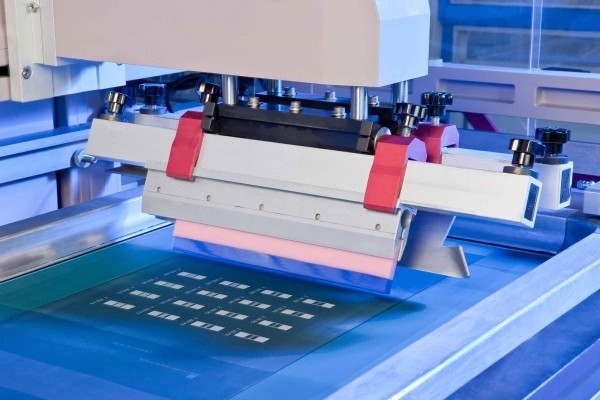
Author: Ali Kosari Mehr
Screen printing
Being a thick film deposition method, screen printing can be utilized for the deposition of uniform coatings on flat substrates; however, one should bear in mind that the method is usually deployed for the deposition of patterned films. The name of the method comes from the screen utilized in the process of deposition. An ink, a screen/mesh comprised of fine holes (plastic/metal fibers woven), a squeegee (a flexible rubber bar), and a substrate are involved in the process. Accordingly, the ink is introduced at the top of the mesh, and the substrate is positioned under the mesh with a small separation (up to 1 mm) being present between the substrate and the mesh. This separation can guarantee the alignment/quality of the printed films. For the deposition of the ink, the ink is dragged over the mesh by the squeegee, as a result of which the mesh touches the substrate surface and the ink is pressed through the holes of the mesh. After the squeegee passes a certain point, that part of the mesh returns to its original position while the ink remains on the substrate surface.
Before the ink is pressed by the squeegee, that the inks introduced at the top of the mesh do not pass through its fine holes requires the inks to have a high viscosity in their equilibrium state and adequate shear-thinning properties. After the ink is pressed through the mesh holes, it easily flows through the mesh holes since the shear stress caused by squeegee reduces the ink viscosity. When the shear stress is removed, the ink viscosity decreases, resulting in the ink not further spreading over the substrate surface. The mesh thickness and the ink makeup govern the thickness of the films; the thicker the meshes used, the thicker the films deposited. The method’s thickness capability, ink viscosity range, and powder loading are 10–30 μm per layer (up to ~200 μm), 1-10 Pa-s, and 10–40 vol%, respectively. In this regard, two points should be taken into account: First, the ink has to be sufficiently fluid in order that it could reflow into the voids left by the mesh wire. Second, the ink has to be sufficiently solid in order that it may not spread to a greater extent than is necessary.
Given that the inks used in this process receive prolonged exposure to the atmosphere owing to the relatively slow process of screen printing, a successful deposition process hinges upon the volatility of the solvent. Thus, carrier fluids having a slow evaporation rate (e.g., pine oil) are utilized in the process to ensure that the inks dry sufficiently slow.
References:
- Dorey R (2012) Thick-film deposition techniques: How to make thick films – the processing techniques used to create films. Ceram Thick Film MEMS Microdevices 63–83. Webpage
-
 20 Aug, 2022What is Auger electron spectroscopy?
20 Aug, 2022What is Auger electron spectroscopy? -
 13 Jul, 2022Classification of vacuum pumps
13 Jul, 2022Classification of vacuum pumps
